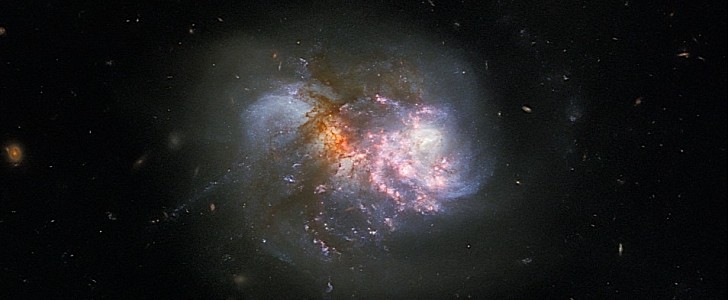Our generation will certainly not be around by then, and it’s unclear what will happen to humanity as a species, but in about 4.5 billion years, our galaxy will not be anything like we know it, thanks to a mammoth galactic event that will see the Milky Way merging with nearby Andromeda.
As per the most recent information, Andromeda and all its gazillion stars and maybe even planets is hurtling towards our Milky Way at speeds estimated at 68 miles per second (109 km/second). That’s incredibly slow, by the Universe’s standards, but a reality that remains.
Now, don’t go imagining a galactic collision necessarily involves celestial bodies slamming into each other with catastrophic consequences. Because the distances between these bodies are huge in both galaxies, there’s a good chance something so dramatic will not take place, and the entire collision will result in nothing more than some stars being ejected from the nascent, combined galaxy - still, a possibly tragic event for the worlds circling these stars.
As said, we will long be gone by then, but we do have a chance of seeing how the event might look like thanks to all the gear we presently have peering into the distant universe.
What you’re looking at now is called by astronomers interacting galaxy pair IC 1623, located 275 million light-years from Earth in the constellation Cetus. According to the European space agency (ESA), which released the photo last week, the “two galaxies are in the final stages of merging.”
The Hubble telescope first discovered the IC 1623 in 2008 “using two filters at optical and infrared wavelengths using the Advanced Camera for Surveys.” According to ESA, this new image “incorporates new data from Wide Field Camera 3, and combines observations taken in eight filters spanning infrared to ultraviolet wavelengths to reveal the finer details of IC 1623.”
Astronomers expect that as the two galaxies get more intertwined (they probably did long time ago, given the immense distance to them) “a powerful inflow of gas to ignite a frenzied burst of star formation.” The future Webb telescope will be trained on this spot in the Universe as well, hoping to unlock its secrets.
Now, don’t go imagining a galactic collision necessarily involves celestial bodies slamming into each other with catastrophic consequences. Because the distances between these bodies are huge in both galaxies, there’s a good chance something so dramatic will not take place, and the entire collision will result in nothing more than some stars being ejected from the nascent, combined galaxy - still, a possibly tragic event for the worlds circling these stars.
As said, we will long be gone by then, but we do have a chance of seeing how the event might look like thanks to all the gear we presently have peering into the distant universe.
What you’re looking at now is called by astronomers interacting galaxy pair IC 1623, located 275 million light-years from Earth in the constellation Cetus. According to the European space agency (ESA), which released the photo last week, the “two galaxies are in the final stages of merging.”
The Hubble telescope first discovered the IC 1623 in 2008 “using two filters at optical and infrared wavelengths using the Advanced Camera for Surveys.” According to ESA, this new image “incorporates new data from Wide Field Camera 3, and combines observations taken in eight filters spanning infrared to ultraviolet wavelengths to reveal the finer details of IC 1623.”
Astronomers expect that as the two galaxies get more intertwined (they probably did long time ago, given the immense distance to them) “a powerful inflow of gas to ignite a frenzied burst of star formation.” The future Webb telescope will be trained on this spot in the Universe as well, hoping to unlock its secrets.

